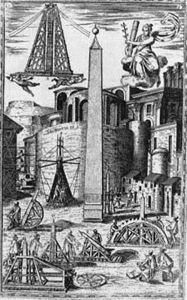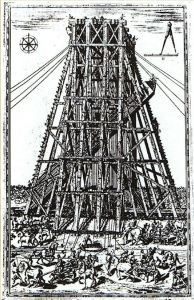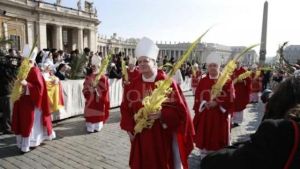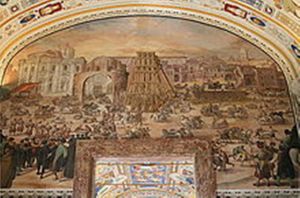Seaman and Honorary Captain of the Pontifical Guards
 He was born in 1530 into a Sanremasca family (according to some scholars his origins are bordigotte), he was a sea captain, who in some texts appears with the name of "Giacomo Bresca"; he married Maria Barnaba in 1595 and died in Sanremo in 1603.
He was born in 1530 into a Sanremasca family (according to some scholars his origins are bordigotte), he was a sea captain, who in some texts appears with the name of "Giacomo Bresca"; he married Maria Barnaba in 1595 and died in Sanremo in 1603.
The surname Bresca is documented in the history of Sanremo in the past centuries and a Benedetto Bresca, son of Raimondo, is mentioned with his brother Francesco in an act of the notary Fizero in 1562. His historical figure is mainly linked to the episode of the raising of the obelisk in St. Peter's Square in Rome in 1586.
Moreover, some scholars have questioned the historical truthfulness of this event because of the total absence of documents on the subject, thus fuelling the legendary aura that surrounds him.
The great obelisk in St. Peter's Square was transported from Egypt to Rome in the first century A.D. under Emperor Caligula and, at the time of Pope Sixtus V, it was located in the gardens near the Constantinian basilica of St. Peter's, now forgotten and covered with almost eight metres of mud and stagnant water. It was Giacomo della Porta who brought it to light on the orders of Sixtus V, who, struck by the majestic beauty of the monolith, prepared the study of various projects for its erection in St. Peter's Square.
In the end he chose that of the architect Domenico Fontana (1543-1607), also because of the enterprising confidence with which the latter intended to tackle the enterprise. To transport and raise the obelisk, however, imposing preparatory work was necessary, while a pope's ban on the street corners ordered the people to remain silent during the uprising, on pain of beheading.
 On 10th September 1586, the day set for the raising of the obelisk, about nine hundred men gathered in St. Peter's Square for the erection of the monolith, and they were joined by a huge crowd, barely contained by the Vatican guards. Very slowly, amidst the squeaking of the winches manoeuvred by 44 horses, the obelisk began to rise until it reached an almost vertical position, but at this point an unforeseen event came up that disrupted the plans of the architect Fontana and put the completion of the work at serious risk: the ropes, tried by the effort, had in fact stretched due to traction and were dangerously fraying, while the winches, jammed by too much rope, had stopped.
On 10th September 1586, the day set for the raising of the obelisk, about nine hundred men gathered in St. Peter's Square for the erection of the monolith, and they were joined by a huge crowd, barely contained by the Vatican guards. Very slowly, amidst the squeaking of the winches manoeuvred by 44 horses, the obelisk began to rise until it reached an almost vertical position, but at this point an unforeseen event came up that disrupted the plans of the architect Fontana and put the completion of the work at serious risk: the ropes, tried by the effort, had in fact stretched due to traction and were dangerously fraying, while the winches, jammed by too much rope, had stopped.
After a few moments, in the midst of an anguished silence, the cry "Aiga a-e corde!" (water on the ropes!) suddenly broke out, which tradition has attributed to the Bresca, fragmentated among the people crowding the square. Fontana, already ready to run away, sensed that the admonition could be effective and ordered, sitting down, to spray the ropes abundantly with the same water used to give the horses a drink, so that, suddenly, without any other manoeuvre, the obelisk stood upright resting perfectly on the base.
An irrepressible joy invaded all those present and the workers, among the exultant crowd, rushed towards Fontana to bring it in triumph before the pope, while Bresca was arrested for having broken the pontifical prohibition not to speak; he feared for his life knowing the particular severity of Sixtus V and his scarce propensity to pardon those who had dared to transgress his orders. However, the fears of the Sanremo sailor were fortunately unfounded as, when he was brought before the Pope, he received his solemn blessing and a fraternal embrace.
 As a further reward, the pope also raised him to the rank of honorary captain of the papal guards, at the same time giving him the right of the papal banner on the commanded ship, and, at the request of Bresca himself, granted him the highest privilege of the perpetual supply to the Vatican of the palm leaves of the Ligurian Riviera on the Sunday before Easter.
As a further reward, the pope also raised him to the rank of honorary captain of the papal guards, at the same time giving him the right of the papal banner on the commanded ship, and, at the request of Bresca himself, granted him the highest privilege of the perpetual supply to the Vatican of the palm leaves of the Ligurian Riviera on the Sunday before Easter.
This privilege was therefore also confirmed to his descendants, who still today supply their characteristic worked and woven palms to the Apostolic Palace and the three major basilicas for the solemnity of Palm Sunday.

 The episode which saw the Matutian sailor as protagonist was also immortalised in a plaque above the second window of the Sistine Library, while a subsequent testimony would prove the authenticity of the privilege of providing the palms: when Giacomo Bresca, a descendant of Benedict, arrived in Rome with a load of palms, met Pope Pius VII with a group of children each holding a worked palm tree from western Liguria, the Pontiff, as a sign of gratitude, had two of them placed in his carriage and, for the occasion, confirmed to our fellow citizen the ancient privilege granted over two centuries earlier to the brave sailor of the famous cry of St. Peter's Square.
The episode which saw the Matutian sailor as protagonist was also immortalised in a plaque above the second window of the Sistine Library, while a subsequent testimony would prove the authenticity of the privilege of providing the palms: when Giacomo Bresca, a descendant of Benedict, arrived in Rome with a load of palms, met Pope Pius VII with a group of children each holding a worked palm tree from western Liguria, the Pontiff, as a sign of gratitude, had two of them placed in his carriage and, for the occasion, confirmed to our fellow citizen the ancient privilege granted over two centuries earlier to the brave sailor of the famous cry of St. Peter's Square.
(Sources: Vite di Sanremesi Illustri di A. Gandolfo; images from Private Archive and Web)




